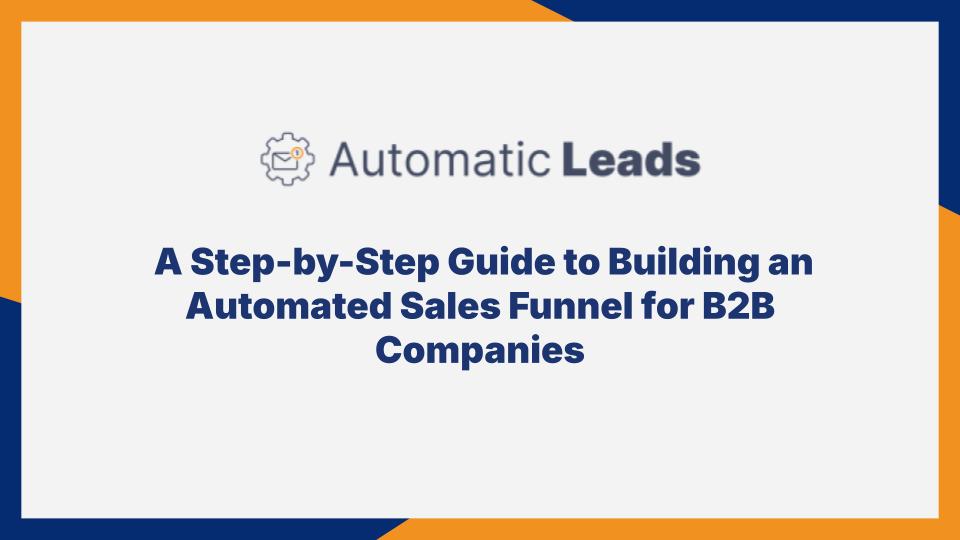In today’s competitive B2B landscape, businesses need efficient and scalable ways to generate leads, nurture prospects, and convert them into loyal customers.
An automated sales funnel is an effective solution for achieving this.
By automating key stages of the funnel, you can streamline your lead generation process, enhance customer engagement, and improve conversion rates — all while freeing up valuable time for your sales team.
In this guide, we’ll walk you through the essential steps to building an automated sales funnel for your B2B company.
Step 1: Define Your Ideal Customer Profile (ICP)
Before you start building your sales funnel, it’s crucial to have a clear understanding of who your ideal customers are.
An Ideal Customer Profile (ICP) outlines the characteristics of the businesses that are most likely to benefit from your products or services.
Consider factors like:
- Industry
- Company size
- Revenue
- Location
- Key decision-maker roles
By identifying your ICP, you can focus your efforts on prospects who are most likely to convert, ensuring a more efficient and effective sales process.
Step 2: Map Out Your Sales Funnel Stages
A typical B2B sales funnel includes several stages, from initial awareness to post-sale engagement. While the specifics can vary, the stages generally include:
- Awareness – Prospects become aware of your brand or solution.
- Interest – They express interest in learning more about what you offer.
- Consideration – They evaluate your solution against competitors.
- Decision – They decide to purchase and move forward.
- Retention – Post-sale activities that ensure customer satisfaction and loyalty.
By defining each stage, you’ll have a clearer picture of where automation can be most beneficial in guiding prospects through the funnel.
Step 3: Create Targeted Lead Magnets
Lead magnets are valuable pieces of content or resources that attract prospects and encourage them to share their contact information.
Examples include whitepapers, industry reports, webinars, and case studies. Each lead magnet should be tailored to address a specific pain point or need of your ICP.
Automated systems can be set up to deliver these resources instantly once a prospect fills out a form or clicks a link, saving time while ensuring quick and efficient delivery.
Step 4: Develop Automated Nurture Sequences
Once a lead enters your funnel, the next step is to nurture them through automated email sequences.
These sequences provide timely and relevant content to help move prospects through each stage of the funnel.
Here’s how you can design an effective nurture sequence:
- Awareness Stage: Share educational content, such as blog posts or industry insights, to help them understand the problem your solution addresses.
- Interest Stage: Offer more in-depth content, like case studies or product demos, to build interest and highlight the benefits of your solution.
- Consideration Stage: Provide comparisons, testimonials, and customer success stories to help them evaluate your offering and see why it stands out.
- Decision Stage: Send personalised offers, free trials, or consultations to encourage prospects to take the next step and make a purchase.
These sequences can be triggered based on the prospect’s actions, such as downloading a resource or visiting a specific page on your website, ensuring they receive content that aligns with their level of interest and engagement.
Step 5: Utilise Personalisation to Enhance Engagement
Personalisation is key to creating an effective automated sales funnel.
By using data points like the prospect’s name, company, industry, and specific interests, you can tailor your messages to resonate more effectively.
Personalised content feels more relevant, making it more likely that prospects will engage with your messages and move further down the funnel.
Automated systems can pull this information from your CRM and insert it into your emails and other communications, making personalisation seamless and scalable.
Step 6: Integrate Lead Scoring for Better Qualification
Not all leads are created equal, so it’s important to prioritise those who are most likely to convert.
Lead scoring assigns points to leads based on their behaviour and characteristics, helping you identify which ones are ready for a sales conversation. Common scoring criteria include:
- Engagement with your content
- Job title and role
- Interaction frequency and recency
- Company size and industry fit
Automating lead scoring allows you to track and assess leads in real-time, ensuring that your sales team focuses on high-quality prospects while automated sequences continue to nurture those who need more time.
Step 7: Measure and Optimise Your Funnel Performance
Finally, an automated sales funnel requires regular monitoring and optimisation to ensure it’s delivering the best results. Track key metrics such as:
- Open and click-through rates for emails
- Conversion rates at each funnel stage
- Cost per lead and cost per acquisition
- Time taken for leads to move through the funnel
By analysing this data, you can identify areas for improvement, such as adjusting messaging, re-targeting different segments, or fine-tuning your lead scoring criteria.
Conclusion
Building an automated sales funnel can revolutionise your B2B lead generation strategy, delivering consistent, high-quality leads with minimal manual effort.
By following these steps — from defining your ICP and mapping out funnel stages to creating personalised nurture sequences and leveraging lead scoring — you can create a powerful system that works for your business around the clock.
With automation, you’ll not only save time and resources but also create a seamless, data-driven process that optimises your lead generation efforts and drives measurable growth.
So, if you’re ready to take your B2B sales funnel to the next level, it’s time to embrace the power of automation.

